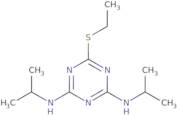Informations sur le produit
- 1,3,5-Triazine-2,4-diamine, 6-(ethylthio)-N,N′-bis(1-methylethyl)-
- 1,3,5-Triazine-2,4-diamine, 6-(ethylthio)-N<sup>2</sup>,N<sup>4</sup>-bis(1-methylethyl)-
- 2-Ethylthio-4,6-Bis(Isopropylamino)-1,3,5-Triazine
- 2-Ethylthio-4,6-bis(isopropylamino)-5-triazine
- 2-Ethylthio-4,6-bis(isopropylamino)-s-triazine
- 6-(Ethylthio)-N<sup>2</sup>,N<sup>4</sup>-bis(1-methylethyl)-1,3,5-triazine-2,4-diamine
- 6-(ethylsulfanyl)-N,N'-di(propan-2-yl)-1,3,5-triazine-2,4-diamine
- Cotofor
- Gs 16068
- Sancap
- Voir d'autres synonymes
- s-Triazine, 2-(ethylthio)-4,6-bis(isopropylamino)-
- 1,3,5-Triazine-2,4-diamine, 6-(ethylthio)-N2,N4-bis(1-methylethyl)-
- 6-(Ethylthio)-N2,N4-bis(1-methylethyl)-1,3,5-triazine-2,4-diamine
Dipropetryn is a herbicide that is used to control weeds in many crops, such as wheat, barley, sugar beet, and cotton. It inhibits photosynthesis by inhibiting the electron transport chain in mitochondria, which decreases the production of ATP. This leads to the inhibition of lipid biosynthesis, which disrupts plant growth. Dipropetryn can also be used for weed control in lawns and gardens. The chemical is applied before or at the time of planting and continues to inhibit weed growth for up to three months after application.
Dipropetryn is a triazine herbicide that inhibits photosynthetic activity by inhibiting electron transport chain in mitochondria. This leads to inhibition of lipid biosynthesis, disrupting plant growth and causing death by lack of nutrients and water. It can also be used for weed control in lawns and gardens with an application before or at the time of planting that lasts up to three months.BR>BR>
Dipropetry





